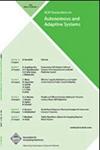Adapting scientific workflow structures using multi-objective optimization strategies
IF 2.2
4区 计算机科学
Q3 COMPUTER SCIENCE, ARTIFICIAL INTELLIGENCE
ACM Transactions on Autonomous and Adaptive Systems
Pub Date : 2013-04-01
DOI:10.1145/2451248.2451252
引用次数: 17
Abstract
Scientific workflows have become the primary mechanism for conducting analyses on distributed computing infrastructures such as grids and clouds. In recent years, the focus of optimization within scientific workflows has primarily been on computational tasks and workflow makespan. However, as workflow-based analysis becomes ever more data intensive, data optimization is becoming a prime concern. Moreover, scientific workflows can scale along several dimensions: (i) number of computational tasks, (ii) heterogeneity of computational resources, and the (iii) size and type (static versus streamed) of data involved. Adapting workflow structure in response to these scalability challenges remains an important research objective. Understanding how a workflow graph can be restructured in an automated manner (through task merge, for instance), to address constraints of a particular execution environment is explored in this work, using a multi-objective evolutionary approach. Our approach attempts to adapt the workflow structure to achieve both compute and data optimization. The question of when to terminate the evolutionary search in order to conserve computations is tackled with a novel termination criterion. The results presented in this article demonstrate the feasibility of the termination criterion and demonstrate that significant optimization can be achieved with a multi-objective approach.采用多目标优化策略适应科学的工作流结构
科学工作流程已经成为在分布式计算基础设施(如网格和云)上进行分析的主要机制。近年来,科学工作流优化的重点主要集中在计算任务和工作流最大跨度上。然而,随着基于工作流的分析变得越来越数据密集,数据优化正成为一个主要问题。此外,科学工作流程可以沿着几个维度进行扩展:(i)计算任务的数量,(ii)计算资源的异质性,以及(iii)所涉及数据的大小和类型(静态与流)。调整工作流结构以应对这些可扩展性挑战仍然是一个重要的研究目标。了解工作流图如何以自动化的方式(例如,通过任务合并)进行重构,以解决特定执行环境的约束,在本工作中使用多目标进化方法进行了探索。我们的方法试图调整工作流结构以实现计算和数据的优化。采用一种新的终止准则来解决何时终止进化搜索以节省计算量的问题。本文的结果证明了终止准则的可行性,并证明了多目标方法可以实现显著的优化。
本文章由计算机程序翻译,如有差异,请以英文原文为准。
求助全文
约1分钟内获得全文
求助全文
来源期刊

ACM Transactions on Autonomous and Adaptive Systems
工程技术-计算机:理论方法
CiteScore
4.80
自引率
7.40%
发文量
9
审稿时长
>12 weeks
期刊介绍:
TAAS addresses research on autonomous and adaptive systems being undertaken by an increasingly interdisciplinary research community -- and provides a common platform under which this work can be published and disseminated. TAAS encourages contributions aimed at supporting the understanding, development, and control of such systems and of their behaviors.
TAAS addresses research on autonomous and adaptive systems being undertaken by an increasingly interdisciplinary research community - and provides a common platform under which this work can be published and disseminated. TAAS encourages contributions aimed at supporting the understanding, development, and control of such systems and of their behaviors. Contributions are expected to be based on sound and innovative theoretical models, algorithms, engineering and programming techniques, infrastructures and systems, or technological and application experiences.
 求助内容:
求助内容: 应助结果提醒方式:
应助结果提醒方式:


